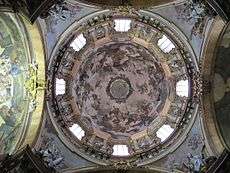St. Nicholas Church (Malá Strana)
| St Nicholas Church | |
|---|---|
| The Church of Saint Nicholas | |
| Kostel svatého Mikuláše | |
|
| |
| 50°5′16.39″N 14°24′11.58″E / 50.0878861°N 14.4032167°E | |
| Location | Prague |
| Country | Czech Republic |
| Denomination | Roman Catholic |
| Website | Website of the Church |
| History | |
| Founded | 1704 |
| Architecture | |
| Status | Active |
| Functional status | Parish Church |
| Architect(s) | Christoph Dientzenhofer |
| Architectural type | Basilica |
| Style | Baroque |
| Completed | 1755 |
| Specifications | |
| Height | 49 meters |
| Dome height (outer) | 79 meters |
| Dome diameter (outer) | 20 meters |
| Spire height | 79 meters |
| Administration | |
| Parish | Lesser Town of Prague |
| Archdiocese | Prague |
The Church of Saint Nicholas (Czech: Kostel svatého Mikuláše) is a Baroque church in the Lesser Town of Prague. It was built between 1704-1755 on the site where formerly a Gothic church from the 13th century stood, which was also dedicated to Saint Nicholas.
History
The original Gothic Parish church of Saint Nicholas stood on the site of the present church which dated from the 13th century. In the second half of the 17th century the Jesuits decided to build a new church designed by Giovanni Domenico Orsi. A partial impression of the original planned appearance of the church at the time the Jesuits chose the initial plans by Giovanni Domenico Orsi in 1673 and laid the foundation stone is provided by the Chapel of St Barbara, which was built first so that mass could be celebrated. The church was built in two stages during the 18th century. From 1703 till 1711 the west façade, the choir, the Chapels of St Barbara and St Anne were built.
The new plans involved an intricate geometrical system of interconnected cylinders with a central dome above the transept. The massive nave with side chapels and an undulating vault based on a system of intersecting ellipsoids was apparently built by Christoph Dientzenhofer. The pillars between the wide spans of the arcade supporting the triforium were meant to maximize the dynamic effect of the church. The chancel and its characteristic copper cupola were built in 1737-1752, this time using plans by Christoph's son, Kilian Ignaz Dientzenhofer.
In 1752, after the death Dientzehofer in 1751, the construction of the church tower was completed. During the years the church continued to expand its interior beauty. Following the abolition of the Jesuit Order by Pope Clement XIV, St Nicholas became the main parish church of the Lesser Town in 1775.
During the communist era the church tower was used as an observatory for State Security since from the tower it was possible to keep watch on the American and Yugoslav embassies respectively and the access route to the West German embassy.
Decoration
It has been described as "the most impressive example of Prague Baroque"[1] and "without doubt the greatest Baroque church in Prague and the Dientzenhofers' supreme achievement".[2]

The church excels not only in the architecture, but also in the decoration, mainly with the frescos by Jan Lukas Kracker and a fresco inside the 70 m high dome by František Xaver Palko. The interior is further decorated with sculptures by František Ignác Platzer. The Baroque organ has over 4,000 pipes up to six metres in length and was played by Mozart in 1787. Mozart's spectacular masterpiece, Mass in C, was first performed in the Church of Saint Nicholas shortly after his visit.[3][4]
The 79 m tall belfry is directly connected with the church’s massive dome. The belfry with great panoramic view, was unlike the church completed in Rococo forms in 1751-1756 by Anselmo Lurago.
Services
The parish church celebrates a weekly mass every Sunday at 8.30pm.
 Panoramic view taken from Petřín
Panoramic view taken from Petřín Front entrance
Front entrance Interior of the church
Interior of the church.jpg) Ceiling fresco depicting the Apotheosis of St. Nicholas
Ceiling fresco depicting the Apotheosis of St. Nicholas
References
- ↑ Neil Wilson, Mark Baker. Prague. 9th edition. Lonely Planet, 2010. ISBN 9781741796681. Page 9.
- ↑ Jack Messenger, Brigitte Lee. Prague. 5th edition. New Holland Publishers, 2008. Page 51.
- ↑ Norman Davies, Europe: A History, A Panorama of Europe, East and West, From the Ice-Age to the Cold War, From the Urals to Gibraltar (New York: Harper Perennial, 1998), 671.
- ↑ According to his widow, Constanze, Mozart loved the architecture of Prague, with its Baroque churches like St. Nicholas - he likewise praised the Orchestra of Prague, calling it his very "own", and was adored by the citizens of Prague. Constanze remarked that, "the Prague public admired and worshiped him wholeheartedly; this consoled Mozart for some of the slights he had received in Salzburg and Vienna." See: Heinz Gärtner, Constanze Mozart: After the Requiem, trans. Reinhard G. Pauly (Portland, OR: Amadeus Press, 1991), 67.
External links
Coordinates: 50°5′16.39″N 14°24′11.58″E / 50.0878861°N 14.4032167°E